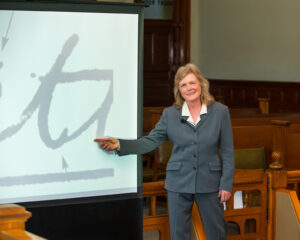Hannah McFarland
Certified Document Examiner & Forensic Handwriting Analyst
Serving Washington State and Beyond
Phone: 360-379-4062 | hannah@writeexam.com
“I find her [Hannah McFarland] to have an excellent analytical style. When she makes a comparison, I can actually see what she is talking about. That would be very impressive to a jury.”
-Stephen R. Kay, Head Deputy District Attorney for Los Angeles (read more testimonials here.)
Basics of Document Examination

Summary of Qualifications
- Certified in 2002 and re-certified four times since then by the National Association of Document Examiners (NADE).
- Testified as an expert witness over 85 times in many venues and jurisdictions including Federal and State Courts in Washington, Oregon, Idaho and Alaska as well as depositions, arbitrations, administrative hearings and other legal proceedings.
- I currently serve on the Executive Board of Directors of the National Association of Document Examiners.
Please contact me directly for a copy of my resume.
Basic Information about Document Examination
No two people write exactly the same way. Nor, for that matter, does one single person as your own signature varies over time. Determining who wrote a given writing or printing sample is accomplished by identifying a combination of handwriting traits that are unique to one person only.
Requirements for Document Examination
Because nobody writes exactly the same way twice, I need to determine how much a person varies his or her handwriting. Doing this requires a sufficient amount of authentic or “known” writing to compare against the questioned handwriting. The following is a guide to what I need in order to conduct a handwriting comparison:
- I prefer to examine original documents. Photocopies do not reproduce the finer features of handwriting such as pressure, ductus, and line crossing.
- Examination of originals also eliminates the possibility of a forgery by cutting, pasting and copying a signature onto a document. The absence or loss of an original can itself be suspicious-especially if the destruction or loss of a document is out of character for the situation. Even so, originals are not always available. In such cases, it is common for document examiners to give a qualified opinion when examining non-originals.
- I need a sufficient amount of known writing, called exemplars, which are used to compare against the questioned writing. Many cases involve questioned signatures. In such cases, five to twenty-five signatures is sufficient; and…
- A person’s handwriting or handprinting habits can change over time. Consequently, the exemplars and questioned writing should be contemporary with each other. Ideally, both bodies of writing should be written with a year or two of each other.
Sometimes the quantity and quality of writing samples available for examination does not exactly meet the criteria listed above. I can still perform the forensic document examination, but may give a qualified opinion.
When there is a very limited amount of exemplars available, it may become necessary to have a person provide writing samples. Writing samples executed for the purpose of handwriting comparison are known as “request writing”.